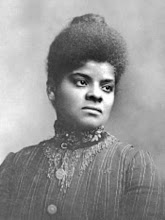I have been reading about what First Lady Michelle Obama and her husband are doing in the White House with the arts. Mrs. O is quoted on the AMERICA.Gov blog post dated May 19, 2009 as saying, “My husband and I believe strongly that arts education is essential for building innovative thinkers who will be our nation’s leaders for tomorrow.” I am inspired by their efforts while saddened that I have to dig around on the internet to find out about these things. How many people know that on October 2, 2009 President Obama declared October as National Arts and Humanities Month? How many people know that last July Michelle Obama brought together representatives from major art institutions to the White House to discuss how to make the arts more accessible to people with disabilities? I didn't know that until recently. But maybe I'm the only one.
Anyway, this got me thinking about black women in the arts. I started doing a little research and discovered the life and work of Meta Vaux Warrick Fuller, often considered one of the pioneering black women in sculpture and visual art in America.
Although often classified under the Harlem Renaissance, Meta actually did all her work in Paris, Pennsylvania, Boston and Framingham, MA. She was born in Philadelphia on June 9, 1877 and raised in middle class America by her father, a barber and a lover of the arts and her mother, a wigmaker. At the young age of 16 Meta Fuller won a three-year scholarship to study at the Pennsylvania School of Industrial Art. From 1899-1902 she studied in Paris at the Academie Colarossi and at the Ecole des Beaux Arts, While in Paris she met African American artist Henry Ossawa Tanner and received private instruction from French artist Auguste Rodin.
When Meta returned to the USA she found that the Philly art society was not ready to embrace a black female artist as openly as they had in Paris. But she persevered in her talents and passion for the arts. From 1903-1907 she continued her education at the Pennsylvania Academy of the Fine Arts in Philadelphia and in 1907 was commissioned to create art for the Jamestown Tercentennial Exposition. Her art depicted the progress of African Americans since their 1619 arrival in Jamestown, VA. She became the first black female artist to receive a federal commission for her work.
In 1910, just three years later a warehouse fire in Philadelphia destroyed 16 years worth of her artwork. Despite this devastating loss Meta continued creating and turned her sights to art that celebrated African and African American strength of spirit, historical struggle and heritage. Her work depicted the suffering and joys of the human condition. She did not shy away from uncomfortable subject matter. Around 1914 she created one of her most famous pieces, Ethiopia Awakening (Schomburg Center for Research in Black Culture, New York Public Library.) This sculpture symbolized several things; the African American lineage to North Africa, the bourgeoning of African American culture in mainstream society, and the call for African Americans to recognize the intellectual and spiritual influence that Africa could have on their ongoing formation in racist America. Meta was one of the first female artists to encourage art with afro-centric themes, art that did not cater to white ideals. There were many factors influencing Fuller’s art including African American philosophers and educators such as Alain Locke and W.E.B. Dubois.
In 1937 Fuller created Talking Skull, (Museum of Afro-American History, Boston, MA) a powerful sculpture of a man kneeling on a corpse in apparent conversation with a skull. Other Fuller sculptures worth seeing are Silence and Repose, and Sorrow (private galleries.)
Fuller was also an accomplished painter. During the Civil Rights Movement she painted pieces to honor the men who walked with Dr. MLK across the Edmund Pettus Bridge on March 9 (The Good Shepherd) and when the four little black girls died in the bombing of Sixteenth Street Baptist Church in Alabama Fuller painted The Crucifixion.
She died on March 18, 1968 at 90 years old. She was a wife to Dr. Solomon Fuller, a West African immigrant, and a mother of three.
Learn more about Meta Fuller online at The University of the Arts Library http://library.uarts.edu/archives/alumni/warrickfuller.html
Tuesday, November 10, 2009
Subscribe to:
Post Comments (Atom)







Enuma, this is truly beautiful. The world needs your gift! --Sarah
ReplyDeleteIndeed, you ARE the gift. Thank you, wise friend. (I can't wait to show my daughter!)
ReplyDeleteThanks for sharing this love!
ReplyDeleteThanks for this moving entry. I give tours through Black history in Paris and it's my immense pleasure to point out where Meta Warrick Fuller studied there. So many people don't know of her... yet.
ReplyDeleteIf you come to Paris, you are most welcome on our tours. www.walkingthespirit.com
and facebook http://www.facebook.com/pages/Walking-The-Spirit-Tours-Black-Paris-Beyond/185119741523801
Thanks,
Julia Browne
Walking The Spirit Tours
I am taking an art class in college. I am 45 years old and never gave much thought to art until this class. Already I have started appreciating art and artists. Our first essay, our introductory essay is to look through our book and find a picture of art that speaks to us. When I saw the picture of Meta's "Talking Skulls" I was hooked. Having lost several family members in the last couple of years, the most devastating being my 25 years old son, this sculpture spoke to my heart and my daily wishes. It is really sad that racism has been so ramped in America, being Native American I understand how hard it has been for African Americans. Thank you so much for this blog, it has opened my eyes in a lot of new ways.
ReplyDeleteJoyce